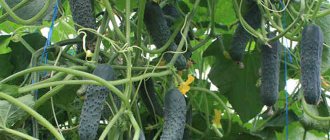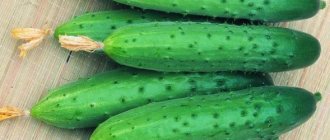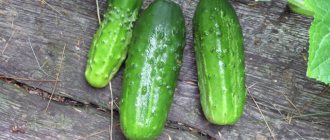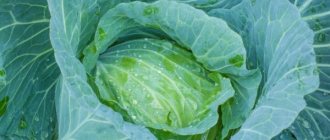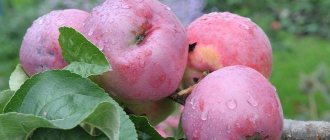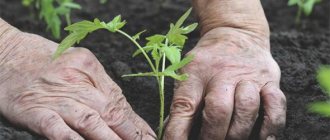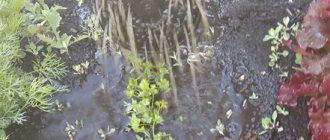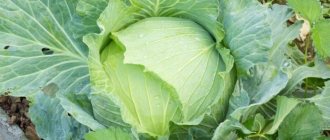Dutch vegetable hybrids are loved by gardeners and farmers around the world. They are disease resistant, productive and have an excellent presentation. The Marinda F1 cucumber is endowed with all these qualities, and its taste is not inferior to other characteristics: it is fresh and pleasant, and therefore has universal use - salad and pickling.
| Landing location | Ripening time | Mode of application | Fruit length | Group | Fruit smoothness | Pollination method |
| Universal | Early ripening (35-45 days) | Universal | Short (gherkins) - less than 10 cm | Hybrid | Highly lumpy | Parthenocarpic |
Description and characteristics of the hybrid Marinda F1
The early-ripening hybrid Marinda is a universal hybrid because it is suitable for canning and preparing fresh salads. The variety is self-pollinating; each node bears up to seven fruits. It takes 45-50 days from seed germination to the appearance of the first ripe cucumbers.
Cylindrical cucumbers of a dark green hue grow 8-11 cm long, weighing 60-70 g. From a square meter of land you can collect 25-30 kg of cucumbers. On the surface of ripe vegetables, characteristic tubercles with small whitish spines remain. The crispy flesh of Marinda cucumbers is not bitter at all, and the seed chambers are small.
The crop exhibits resistance to several common diseases: scab, powdery mildew, cladosporiosis, leaf spot.
The super-early cucumber variety Amur F1 exhibits similar qualities. To ensure that the harvest at the end of the season does not disappoint, it is recommended to buy seed material from special companies - "Flora", "Russian Garden").
Fruits without bitterness with white thorns - cucumber Miranda f1: description of the variety
The Miranda f1 cucumber is perfect for summer residents in central Russia and even in risky farming zones. This is a hybrid of domestic selection, specially adapted for cool growing conditions. It is persistent and unpretentious, and the taste of the fruit is beyond praise.
| Landing location | Ripening time | Mode of application | Fruit length | Group | Fruit smoothness | Pollination method |
| Universal | Early ripening (35-45 days) | Universal | Medium – from 10 to 15 cm | Hybrid | Highly lumpy | Parthenocarpic |
Description and characteristics of the variety
Bushes of indeterminate type, spreading and powerful. The leaves are medium. The ovaries are formed in small bunches of up to 3 pieces.
The first harvest is harvested 40-45 days after germination of the seedlings. Zelentsy are about 11-12 cm long and weigh on average 100-110 grams. The thick skin has stripes and tubercles, and the spines are white. The pulp is devoid of bitterness, has an excellent taste, aromatic and juicy. Universal use.
Advantages and disadvantages
- great taste;
- excellent appearance and commercial quality;
- keeping quality of fruits and the ability to withstand transportation;
- cold resistance and stress resistance;
- immunity to major diseases;
- early ripeness;
- no need for pollination.
Minuses:
- inability to obtain seeds;
- fruits may outgrow;
- vulnerability to bacteriosis.
Advantages and disadvantages of cucumber
The attention of experienced gardeners is attracted by several main advantages of the Marinda F1 cucumber variety:
when transported over long distances, the shape and taste of the fruit are well preserved;
- possibility of getting an early harvest;
- excellent taste;
- compact size of ripe fruits;
- stability of yields;
- resistance to some diseases.
The Marinda hybrid is not a capricious variety and does not require special care. But beginning gardeners should take into account that this variety is susceptible to anthracosis and angular spot. Therefore, it is important not to miss the appearance of the first signs of the disease.
History of the variety's creation
The Dutch agricultural company Monsanto is well known to vegetable growers from around the world, as its specialists are developing new varieties of various vegetable crops that are distinguished by high yields, excellent taste and marketability of fruits, good immunity, and also have a number of other positive qualities. This company is also engaged in the production and sale of seed material.
Photo of Marinda cucumber
The hybrid cucumber Marinda was also bred by Dutch breeders from this company. One of the main advantages of this variety is its enormous yield, thanks to which the variety quickly became popular among vegetable growers from different countries.
In Russia, this hybrid was included in the State Register in 1994,
it is recommended for cultivation in the central regions of the country, not only in garden beds, but also in closed ground conditions.
Subtleties of growing varieties
When planting Marinda cucumbers, it is necessary to take into account the climatic features of the region. To get an early harvest in the southern regions, it is enough to sow the seeds immediately in the garden. And in cooler regions, it is preferable to plant seedlings in the ground.
Direct planting in open ground
The main advantage of the method is that the plants immediately adapt to the soil and do not experience stress during transplantation.
Expert opinion
Stanislav Pavlovich
Gardener with 17 years of experience and our expert
Ask a Question
Important! Marinda hybrid seeds are sown in the garden after the threat of spring frost has passed.
Manufacturers sell seeds of the Marinda hybrid in processed form (etched, with a special protective coating) and organic. If treated seeds are planted, then it is enough to check them for germination (soak them in salted water and discard any floating empties) and germinate them immediately before sowing.
See also: What are parthenocarpic cucumbers and how to grow them
In addition to testing for germination and germination, organic seeds of the Marinda hybrid are pre-disinfected in a weak solution of potassium permanganate.
It is recommended to select a well-lit place for sowing, protected from drafts. If the beds are raised by 20-30 cm, the seeds will sprout faster and develop better. The holes are made 2.5-3 cm deep, the distance between them in the row is 30 cm, between the rows - 40-50 cm. The sowing is covered with film or agrofibre until the seed germinates.
Growing by seedlings
This method requires pre-filling separate containers or cups with nutrient soil. The main stages of growing seedlings:
- The seeds are immersed in a salted solution to discard the empty ones. Seeds that have settled to the bottom are suitable for planting.
- The seed material of the Marinda hybrid is washed from salt water and, for disinfection, immersed for 20-30 minutes in a weak solution of potassium permanganate, then washed.
- Holes are made in the soil 1.5-2 cm deep, where the seeds are placed. The recesses are lightly sprinkled with earth.
- All containers are covered with glass or polyethylene. The first shoots usually appear after 3-4 days and then the covering material is removed.
Hardening of Marinda F1 seedlings begins 7-10 days before planting in the garden or greenhouse. Containers with seedlings are taken out into the open air for a certain time, which is increased every day.
Seedlings that have grown 3-4 leaves are suitable for transplantation. Weather conditions are considered suitable when the soil warms up to 15-17°C.
Advice! It is not advisable to overexpose the seedlings, otherwise the foliage will begin to turn yellow.
Soil requirements for planting
Cucumbers are an unpretentious plant, but to get a good harvest, you need to choose the right soil for growing .
It is better to plant them in fertile soil with a high humus content. There should not be a lot of nitrogen in the ground, since this element does not have a very good effect on the development of cucumbers.
The bed should be located in a well-lit place . There should be no wind or drafts. If there is insufficient lighting, the tops will grow weak and thin, the harvest will be poor, and the commercial quality will also suffer.
How to properly care for a plant
It is important to perform simple agricultural practices correctly so that delicate plants develop well.
Watering and fertilizing
It is recommended to water the Marinda hybrid with warm water so as not to provoke the occurrence of fungal diseases. Approximate watering schedule:
- Cucumber beds are irrigated every other day or two (depending on climatic conditions) before the flowering phase begins. Half a liter of water is allocated per plant;
- During the period of ovary formation, watering is reduced to once every 2-3 days, while increasing the rate. 8-12 liters are poured onto a square meter bed;
- When the period of abundant fruiting of the Marinda variety is over, reduce the watering rate and regularity. It is enough to pour 0.5-0.75 liters of water under the bush once a week.
The feeding schedule is also drawn up based on the growing season. Marind hybrid seedlings are fed with nitrogen-containing compounds (ammophoska or a solution of bird droppings). At the stages of flowering and ovary formation, the need for phosphorus and potassium in plants increases. The following mixture solution is used: 25 g of potassium nitrate and 50 g of urea are diluted in 10 liters of water.
To prolong the fruiting of the Marinda cucumber, foliar irrigation is carried out. To do this, the bushes are sprayed with urea. To prepare the solution, 15 g of powder is diluted in a 10 liter bucket of water.
See also: How to properly plant cucumbers in open ground
Formation
Greenhouse cultivation of the Marinda hybrid involves the installation of trellises. In order for the cucumber bush to fully develop and be easier to care for, it needs to be shaped. As a rule, one stem is left in the bush, which must be pinched at the level of the upper edge of the trellis. Experienced gardeners recommend pinching shoots and flowers that grow in the axils of the first three leaves.
There is no need to injure or pinch the stem of Marinda cucumbers grown in a spread. Of course, if about 8 leaves have grown on the stem, but no side shoots have appeared, the stem is pinched. To stimulate the growth of side shoots.
How to feed Marinda cucumbers
This variety of cucumbers should be fed quite often.
If a sufficient amount of fertilizer was added to the beds before planting the seedlings, then in the spring you no longer need to feed the cucumbers.
During the budding period, the following fertilizer is applied to the Marinda cucumber bushes:
1 tbsp. l. potassium nitrate, 100 g ash, 2 tbsp. l. ammonium nitrate and 2.4 tbsp. superphosphate is diluted in a bucket of water and the cucumber bushes are watered.
For active formation of ovaries, cucumbers need to be watered with the following solution:
dilute 1.5 tbsp in a bucket of water.
l. potassium nitrate, 4 tbsp. l. urea, 100 g of ash and feed these vegetable plants. In the last ten days of August - the first ten days of September, to prolong fruiting, you can fertilize Marinda cucumbers “by leaf”:
dilute 1 tbsp in a bucket of water.
l. urea and spray the cucumber vines with this solution from a spray bottle. Foliar feeding should be done either early in the morning or in the evening. If it rains after such feeding, it is better to repeat the procedure.
Methods of protection against diseases and pests
The Marinda F1 variety is resistant to many diseases. However, some fungal infections can cause problems for cucumber beds. The most common:
- Anthracnose appears on foliage as blurry yellow-brown spots due to humid heat. If treatment is not started in time, the fungi will attack the stem and fruits. Spraying the bushes with Bordeaux mixture or Burgundy liquid helps fight the disease;
- with peronosporosis (downy mildew), the foliage becomes covered with small yellow spots, which gradually expand and acquire a gray-violet tint. The appearance of fungus is provoked by moistening the soil with cold water and increased humidity. Plants are treated with a solution of Bordeaux mixture or the drug "Ridomil".
Snails and slugs also cause damage to Marinda cucumber bushes. Pests have to be collected manually (it is better to act at night). Preventive control measures - weeding the beds, spraying wood ash between cucumber bushes.
Cucumber Health Root
If the seedlings outgrow the thirty-day time threshold, problems with the root system are inevitable. It can weaken and lead to the death of the plant. The disease can affect not only seedlings, but also grown cucumber bushes.
The yield of a melon crop is determined by what kind of roots the cucumbers have, how healthy they are and how capable they are of feeding the plant. The underground part of the cucumber bush undergoes changes throughout its life. At first, they spread their network close to the surface, feeding the sprout with useful substances. Then the root is buried more than a meter to extract all the nutrients from the deep layers of the soil. Therefore, it is important to prevent damage or cooling of the roots at the very beginning of their life.
Root rot and spider mites are the main enemies of cucumber bushes
The most common disease of the underground part of cucumbers is root rot, which quickly leads to death, which is especially unpleasant at the beginning of the period of fruit formation.
Occurs due to poor-quality contaminated soil, frost damage or wounds caused during loosening of the soil. The only way out is to destroy the diseased bush and cultivate the soil in the hole.
A weakened plant is open to various infections and diseases, attacked by pests and bacteria. The scourge of all melon crops - spider mites in a greenhouse on cucumbers can ruin all efforts to grow the crop. The first signs of a plant being damaged by a mite are small light spots-punctures on the leaves. These holes are so tiny that it is difficult to see them, so most often a mite attack is noticed already at the stage when it entwines several leaves with a web. The most rational thing to do, if one plant is infected, is to destroy the entire bush, but save the rest of the plantings in the greenhouse. When the beds are extensively damaged, various chemicals are used. Spider mites get into the greenhouse with soil or on human shoes.
Prevention is the easiest way to health
You can avoid most problems in growing cucumbers if you take a set of preventive measures in a timely manner. Changing the soil annually will reduce pest damage to plants. Treating containers and greenhouse walls with disinfecting solutions is a guarantee against viral and bacterial infections. A simple technique that few people know about, but very useful: owners of greenhouse structures, for preventive purposes, have shoes specially designed for greenhouses, which they wear for working inside. This reduces by almost 100% the likelihood of introducing diseases dangerous to greenhouse “pets” on the soles.
Harvest and storage
The fruits of the Marinda variety are in demand at different stages of formation. The ovary, 3-5 cm long (pickles), is usually used for preservation and pickling. Gherkins (fruits up to 8 cm long) are very popular and are convenient to preserve. Fresh greens of the Marinda F1 variety (up to 11 cm long), which are juicy and aromatic, are usually consumed fresh.
It is best to store the harvest in the refrigerator, tightly wrapping the fruit in a bag. A bulk harvest can be placed in the cellar (no longer than 20-22 days) if the air temperature is not higher than 5-7°C.
General description of Miranda cucumbers
Miranda cucumbers are a universal hybrid that will appeal to many gardeners. Below we present a detailed description in the table, according to which you can easily make your choice.
This hybrid was bred in the 90s in the Moscow region, and in 2003 it was included in the Register of the Russian Federation for cultivation in seven regions. Can be recommended for planting in the southern regions. The Miranda hybrid has a lot of advantages; experts advise planting it in small areas.
Since today there are a large number of varieties and hybrids of cucumbers on store shelves, it is often very difficult to make a choice. Gardeners select the same variety and grow it year after year. But you always want to add variety and try a new variety of cucumbers. A detailed table describing the main parameters of the Miranda cucumber hybrid will help with this.
Table
Cucumber "Miranda f1" is an ultra-early hybrid, it is famous for its high yield.
| Characteristic | Description of the variety "Miranda f1" |
| Ripening period | Ultra-early, 45 days |
| Pollination type | Parthenocarpic |
| Description of fruits | Zelentsy are cylindrical in shape, 11 centimeters long, without bitterness and weighing up to 110 grams |
| Recommended growing regions | Central Black Earth, Northern Caucasus, Middle Volga, Northern and Northwestern regions, Volga-Vyatka and Central regions |
| Resistance to viruses and diseases | Cladospirosis, powdery mildew, fusarium, olive blight |
| Usage | Universal |
| Productivity | Per square meter 6.3 kilograms |
The peculiarity of the Miranda f1 cucumber hybrid is that it can be grown in closed ground conditions. It is for this reason that the hybrid can be successfully grown in the northern regions. You can plant cucumbers of this variety further south, but most often in the Stavropol and Krasnodar Territories, as well as in the Crimea, greenhouses and film shelters are not used. There are a number of features in growing the Miranda f1 hybrid.
Care
The “Marinda F1” cucumber is easy to care for and will not cause much trouble for gardeners:
- Watering should be done once a day in the evening. The soil should be moist, but not too waterlogged. Irrigate with warm and settled water.
- Fertilizer feeding up to 5 times per season. These can be organic or mineral products. The first feeding is carried out no earlier than 15 days after transplanting cucumbers into open ground.
- Form bushes into one stem. For convenience, use the trellis growing method. After 15 days, the main stem is tied to a trellis. Side shoots are pinched after the second/fourth leaf for better branching and a larger yield.
- Loosening the soil and weeding should only be done after watering. To make maintenance easier, you can mulch the soil.
- To control pests, spray the foliage and stems of cucumbers with special preparations as needed. For slugs, metaldehyde 5% is used, for mites - dispersed sulfur, for melon aphids - a mixture of 10 g of red pepper + 200 g of tobacco dust + 10 l of water at a temperature of 60C.
- To increase the yield, collect fruits once every three days. Early morning or evening is the best time to harvest. Cucumbers are cut with a knife or scissors, keeping the stalk.
"Meringue F1": biological description, history of selection
The hybrid is the result of the work of a subsidiary of the breeding and seed agricultural company Monsanto. The packaging may contain either the name of a large corporation or a subsidiary – Seminis. It was in the experimental plots of the latter that “Merengue F1” saw the light of day. The hybrid was included in the State Register of Breeding Achievements of the Russian Federation in 2007, simultaneously with the start of vegetable imports from Holland. Cucumber “Merengue F1” is approved for cultivation in all regions under film and in open ground.
Bushes
Plants are medium-sized with light branching. However, thanks to the good foliage of the vine, the bushes look dense. Smooth, wrinkle-free, medium-sized leaf blades are colored intensely green. Female flowering type. Pollination occurs without bees, which makes the hybrid suitable for cultivation in protected soil. Shoots have the ability to quickly regenerate: they quickly recover from damage.
Fruit
The type of formation of greens is bunched. Up to four gherkin-type fruits develop in the leaf axils. The length of greens rarely exceeds 10 cm. Diameter - 4 cm. Weight of a marketable cucumber - 80-100 g. Straight, cylindrical fruits, sometimes with a slight bend, are covered with thin skin with large tubercles, which are topped with white spines. Zelentsy, even if removed from the vine late, are not prone to overgrowth and yellowing. The pulp is aromatic, dense, creating a crunch when broken.
Agricultural technology for growing seeds in open ground
Hybrid parthenocarpic cucumbers have one feature - you will not get seeds for planting from overripe fruits. You will have to go to specialized stores every time.
It is best to purchase seeds in winter, and only from well-known, trusted manufacturers. They will describe in detail the features of the variety you have chosen, as well as the conditions under which it is kept.
Open ground conditions
Miranda seeds can be planted both in open ground in the garden and in a greenhouse. The greenhouse is preferable, since this variety is created specifically for this method of cultivation
It is only important to follow the technology and be sure to ventilate the room
The place where cucumbers are planted in an open garden should be fairly sunny, not shaded, especially in the central and northern regions. In the southern part of the country, light shading is allowed for several hours a day. You should not plant vegetables in lowlands or holes, where moisture will flow and cold air will begin to linger.
